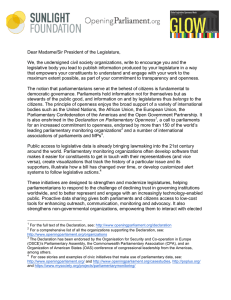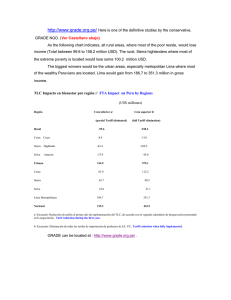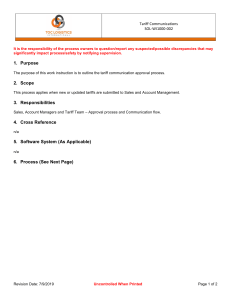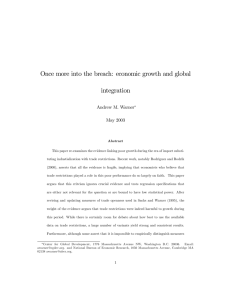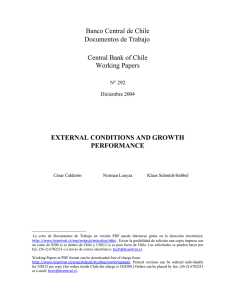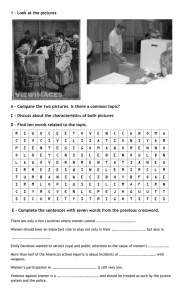1998 EJ 108-447 Edwards Openess Productivity and Growth What We Really Know
Anuncio
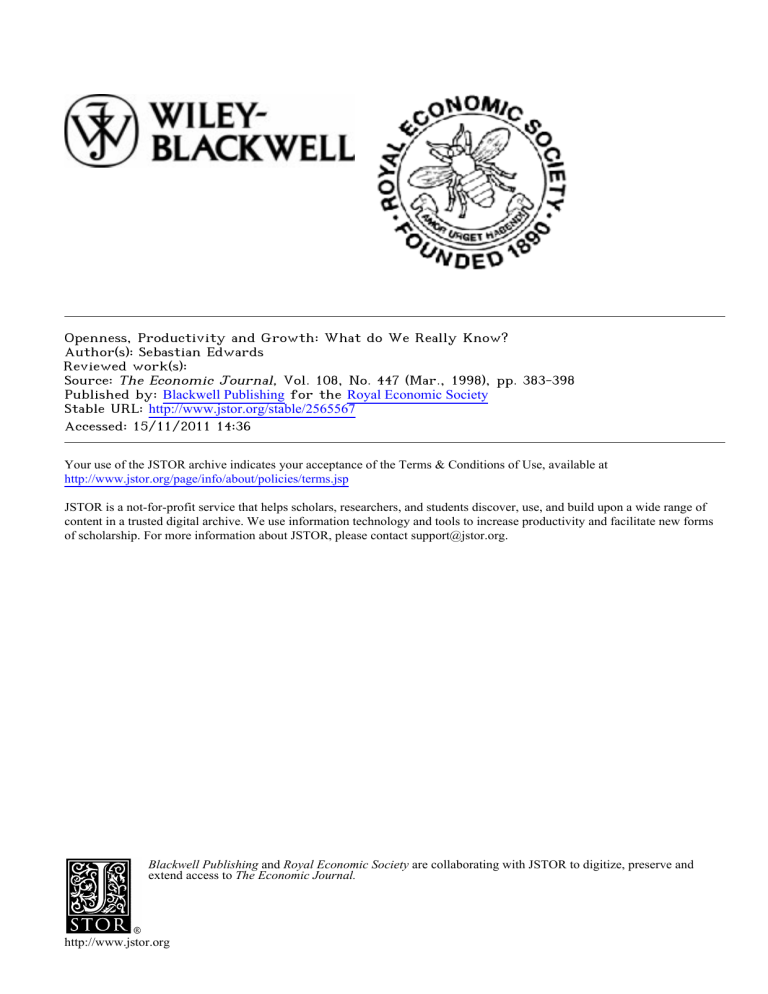
Openness, Productivity and Growth: What do We Really Know? Author(s): Sebastian Edwards Reviewed work(s): Source: The Economic Journal, Vol. 108, No. 447 (Mar., 1998), pp. 383-398 Published by: Blackwell Publishing for the Royal Economic Society Stable URL: http://www.jstor.org/stable/2565567 . Accessed: 15/11/2011 14:36 Your use of the JSTOR archive indicates your acceptance of the Terms & Conditions of Use, available at . http://www.jstor.org/page/info/about/policies/terms.jsp JSTOR is a not-for-profit service that helps scholars, researchers, and students discover, use, and build upon a wide range of content in a trusted digital archive. We use information technology and tools to increase productivity and facilitate new forms of scholarship. For more information about JSTOR, please contact [email protected]. Blackwell Publishing and Royal Economic Society are collaborating with JSTOR to digitize, preserve and extend access to The Economic Journal. http://www.jstor.org The EconomicJourna4108 (March), 383-398. (? Royal Economic Society 1998. Published by Blackwell Publishers, 108 Cowley Road, Oxford OX4 1JF,UK and 350 Main Street, Malden, MA 02148, USA. OPENNESS, PRODUCTIVITY AND GROWTH: WHAT DO WE REALLY KNOW?* SebastianEdwards Comparative data for 93 countries are used to analyse the robustness of the relationship between openness and total factor productivity growth. Nine indexes of trade policy are used to investigate whether the evidence supports the view that total factor productivity growth is faster in more open economies. The results are robust to the use of openness indicator, estimation technique, time period and functional form, and suggest that more open countries experienced faster productivity growth. Although the use of instrumental variables help dealing with endogeneity, issues related to causality remain somewhat open, and require time series analyses to be adequately addressed. Old controversies die slowly. For over a century social analysts have debated the connection between trade policy and economic performance. While according to liberal economists freer trade results in faster growth, some analysts have argued that protectionism may help economic performance. This controversy continues today, even as the world is experiencing an unprecedented period of trade liberalisation, and in spite of numerous empirical studies that claim to have found a positive effect of openness on growth. The most prominent trade liberalisation sceptics include Krugman (1994) and Rodrik (1995), who have argued that the effect of openness on growth is, at best, very tenuous, and at worst, doubtful. Two issues have been at the core of these controversies: first, until recently theoretical models had been unable to link trade policy to faster equilibrium growth. And second, the empirical literature on the subject has been affected by serious data problems.1 During the last decade, however, the 'new' theories of growth pioneered by Romer (1986) and Lucas (1988) have provided persuasive intellectual support for the proposition that openness affects growth positively. Romer (1992), Grossman and Helpman (1991) and Barro and Sala-i-Martin (1995), among others, have argued that countries that are more open to the rest of the world have a greater ability to absorb technological advances generated in leading nations. Barro and Sala-i-Martin (1995, Ch. 8), for example, consider a twocountries world (one advanced and one developing), differentiated inputs, and no capital mobility. Innovation takes place in the advanced (or leading) nation, while the poorer (or follower) country confines itself to imitating the new techniques. The equilibrium rate of growth in the poorer country depends on the cost of imitation, and on its initial stock of knowledge. If the costs of imitation are lower than the cost of innovation, the poorer country will * I thank Andrew Warner for providing me time series of the Sachs-Warneropenness indicator. I am indebted to Alejandro Jara for excellent assistance, and to seminar participants at a seminar at the Banco Central de Chile for helpful comments. I am grateful to Jose De Gregorio and two referees for helpful suggestions. 1 See the surveys by Edwards (1993) and Rodrik (1995). In this paper the emphasis is on policyinduced openness. [ 383 ] 384 THE ECONOMIC JOURNAL [MARCH grow faster than the advanced one, and there will be a tendency towards convergence. In this type of model it is natural to link the cost of imitation to the degree of openness: more open countries have a greater ability to capture new ideas being developed in the rest of the world (Obstfeld and Rogoff, 1996).2 In spite of these theoretical advances, the empirical literature has continued to be affected by some serious limitations. In particular, researchers have been unable to generate satisfactory indexes of trade policy orientation. According to Rodrik (1995), in most studies on openness and growth 'the trade-regime indicator used is typically measured very badly', and 'openness in the sense of lack of trade restrictions is often confused with macroeconomic aspects of the policy regime (p. 2941).' The lack of high quality comparative data on total factor productivity (TFP) has complicated things further, imparing the analysis of the connection between openness productivity growth. The complex nature of commercial policy - international trade can be affected by tariffs, quotas, licenses, prohibition, and exchange controls, among others - suggests that attempts to construct a single indicator of trade orientation may be futile, and will tend to generate disagreements and controversies. This means that in order for research on the relationship between trade policy and growth to be persuasive, its results have to be robust to the way in which (policy-induced) openness is measured. In this paper I use a new comparitive data set for 93 countries to analyse the robustness of the relationship between openness and TFP growth. I use nine alternative indexes of trade policy to investigate whether the evidence supports the view that, with other things given, TFP growth is faster in more open economies. The paper is organised as follows: In Section 1 I review alternative methodoligical approaches used to measure openness. In Section 2 I report new results on the relationship between TFP growth and openness obtained with the new data set. In Section 3 I analyse the robustness of these results. Section 4 contains the conclusions. 1. On the Measurement of Trade Orientation and Openness For a long time economists have tried to provide comparative measures of openness. This has proven to be controversial and elusive. This is illustrated by the fact that while for some South Korea has been an open and outwardorientated economy (Greenaway and Nam, 1988), for others it is a prime example of a semi-closed economy with a high degree of government intervention (Wade, 1994). Many early cross country comparative studies used ready-available data on the external sector as proxies for openness. These have included trade dependency ratios and the rate of growth exports (Balassa, 1982). The main limitation of these indicators is that they are not necessarily related to policy 2 Grossman and Helpman (1991), however, present a model where openness affects growth negatively. ? Royal Economic Society 1998 1998] OPENNESS, PRODUCTIVITY AND GROWTH 385 a country can distort trade heavily, and still have a high trade dependency ratio - and that they are largely endogenous. Some authors have tried to avoid these problems by using (partial) information on policy to classify countries according to the degree to which trade is distorted. The Heritage Foundation index of trade policy - which classifies countries into five categories according to the level of tariffs and other (perceived) distortions - is a good recent example of this approach (Johnson and Sheehy, 1996).3 Michaely et al. (1991) constructed a 'subjective index' of trade liberalisation for their cross country regressions. The World Bank's 1987 World Development Report constructed an 'outward orientation' index for 41 countries at two points in time (see also Greenaway and Nam, 1988). The classification of Korea as a 'strongly outward oriented' country both in 196373 and 1973-85 periods elicited, however, some controversy, since it has been argued that during the earlier years the Korean trade regime was considerably more restrictive than in the latter period (Edwards, 1993). Sachs and Warner (1995) have used a series of trade-related indicators - tariffs, quotas coverage, black market premia, social organisation and the existence of export marketing boards - to construct a composite openness index. Although this indicator is an improvement over previous attempts, it provides only a binary classification - a country is either open or closed. As a result, countries with different degrees of trade intervention are equally classified as open. Also, many of the underlying data used by Sachs and Warner to construct their index are only available at one point in time. Some analysts have tried to use observed values of variables associated with trade restrictiveness as indicators of openness. The most popular among these are tariff averages, average coverage of quantitative restrictions (QRs), and collected tariff ratios (CTR), defined as the ratio of tariff revenues to imports. In addition, some authors have argued that the black market premium for foreign exchange is a good proxy for the overall degree of external sector distortions (Levine and Renelt, 1992). An advantage of these indicators is that they are drawn from observed data, and that they allow for intermediate situations where countries are neither totally open nor totally closed. Pritchett (1991) analysed the relationship between some of these indicators and concluded that they are correlated among themselves somewhat weakly. Pritchett and Sethi (1994) found that 'collected tariff rates (CTR)' underestimated true protection. Using samples of over 3,000 observations for Jamaica, Kenya and Pakistan, they found out that the relationship between official tariff rates and CTRs is not linear. However, they found out that in all cases but one the ordering of official tariff rates and CTRS was maintained. Anderson and Neary (1994) argue that if tariffs are the only form of protection, a unique openness index can be defined as the welfare-equivalent 'average tariff. This indicator is based on the concept of 'average tariff developed by Corden (1966). The change in this index resulting from a trade reform is equal to the weighted average of change in domestic prices. 3 Krueger (1978) is an early attempt to use dummy variables to classify trade regimes. ?) Royal Economic Society 1998 386 THE ECONOMIC JOURNAL [MARCH Anderson (1994) calculated the Anderson-Neary indicator for a group of 23 countries and found that the weighted average tariff tended to underestimate the 'true' degree of trade restrictions. The extent of underestimation is directly proportional to the degree of dispersion in the protective structure. Although the development of this new index is an important step in the evaluation of trade policy, the data requirements for its calculation are quite formidable.4 Serious measurement difficulty arise when there are both tariffs and QRs. Some authors have faced this problem by using regression-based analyses to construct openness indexes. Leamer (1988), for example, used an empirical Hecksher-Ohlin model with nine factors to estimate net trade flows and trade intensity ratios for 183 commodities at the three digit SITC level for 53 countries. He then took the differences between predicted and actual trade intensity ratios as indicators of trade barriers. Wolf (1993) extended Leamer's approach, using a larger set of factors of production, a more disaggregated set of commodities and three alternative base years (1975, 1980 and 1985). He constructed trade orientation indexes as 'the distance between actual trade and the trade predicted by the "true" model in the absence of distortions' (page 60). As Leamer (1988) himself has recognised, however, the usefulness of these type of indexes is not all that clear. To sum up, the discussion in this section has chronicled the quest for finding an appropriate comparative openness index. In spite of significant efforts and ingenuity, there has not been too much progress in this area. The vast majority of indexes continue to be subject to limitations. Most empirical studies on the relationship between trade and economic performance have relied on one - or at most two - of these indexes and have, thus, left themselves open to criticism by reform-sceptics. In my view, the difficulties in defining satisfactory summary indexes suggest that researchers should move away from this area, and should instead concentrate on determining whether econometric results are robust to alternative indexes. The empirical analysis presented in the rest of this paper is an attempt to move in this direction. 2. Openness and Total Factor Productivity Growth: New Results In this section I report results on the relationship between trade policy and productivity growth for a cross-section of countries. I begin by sketching the mechanics of TFP growth in an open economy. I then turn to a description of the data, and I finally present the regression results. 2.1. The Simple Mechanics of TFP Growth and Openness Consider a standard aggregate production function where GDP depends on physical capital (K), labour measured in efficiency units (L) and the stock of knowledge, or total factor productivity (B): Yt = Btf(Kt, Lt). Growth at any 4 The basic data required to calculate these equivalent tariff measures for 30 countries have recently made available in electronic form. See Feenstra et aL (1997). (? Royal Economic Society 1998 1998] OPENNESS, PRODUCTIVITY AND GROWTH 387 moment in time will depend on the rate of change of these three factors.5 Assume that there are two sources of TFP growth: a domestic source associated with innovation - and an international one, related to the rate at which the country is able to absorb (or imitate) technological progress originated in the leading nations. The rate of domestic innovation is assumed to depend on the level of human capital (education); imitation, on the other hand, depends on a 'catch-up' term. That is, countries with a lower initial stock of knowledge will tend to imitate faster than those with a higher initial stock of TFP. The rate of growth of B can be written as: B/B = 6 + H(W-B)/B, (1) where W is the world stock of knowledge assumed to grow at a rate of g; 6 is the domestic rate of innovation assumed to depend on human capital, and not to exceed g (i.e. g > 6). If the country in question is 'the' leading innovating nation, 6 = g, and W = B. Finally, 0 is the speed at which the country closes the 'knowledge gap', and is assumed to depend on national policies, including trade policy.6 In particular, in the spirit of many new models of growth, it is assumed that more open countries have a greater ability to absorb ideas from the rest of the world and, thus, have a higher 0. The country's stock of knowledge will converge to [/ (0 + g - 6)] W, and there will be an equilibrium gap between the country's and the world's level of TFP. This model implies that countries with a more open economy will have a higher steady state stock of knowledge and, with other things given, higher GDP. In steady state equilibrium all countries' TFP will grow at g, as long as 0>6. An important property of this simple model is that countries that liberalise trade will experience transitional productivity growth that exceeeds that of countries that maintain their trade distortions. To sum up, the model sketched here suggests that TFP growth will be positively affected by the level of human capital and openness, and negatively affected by the initial stock of knowledge.7 2.2. Data Totalfactorproductivitygrowth Ten-years averages of TFP growth were constructed for 93 advanced and developing countries - see Appendix for the list. The starting point was the estimation of a random effect growth equation using panel data for 1960-90. The raw data on total physical capital, human capital and real GDP were taken 5 In equilibrium, of course, there will only be per capita growth if there are incentives to accumulate more physical capital (K), or knowledge (B). A sufficient condition to generate steady state growth is that the equilibrium marginal productivity of capital exceeds the rate of time preference. 6 This framework was first proposed by Nelson and Phelps (1966) in the context of human capital accumulation. See Edwards (1989, 1992) for an application to the case of trade policy. 7 Barro and Sala-i-Martin (1995), Grossman and Helpman (1991) and Obstfeld and Rogoff (1996) develop detailed micro models of innovation and imitation with similar implications. (C Royal Economic Society 1998 THE 388 ECONOMIC [MARCH JOURNAL from Neruh and Dhareshwar (1993). The following equation was estimated using 3,555 observations panel data set: gjt = a dlogKjt +,dlogLjt +A+j+t + (2) where ?, c, and $ are a country specific, time specific and common i.i.d error terms, and A is a common fixed effect term. a + ,Bwere restricted to add up to one. The estimated factor shares were then used to construct yearly estimates of TFP growth. Finally, these were averaged to construct decade-long estimates of TFP growth. A 1960-90 average was also constructed. In addition to (2), a growth equation that included human capital as an additional regressor was estimated. These estimates were used to construct a second set of TFP growth series, called TFPH. These two TFP growth variables behave very similarly - a regression of average TFPon average TFPHfor the complete 1960-90 period yielded a slope coefficient of 0.93 with a standard error of 0.04. Two batteries of consistency checks suggest that new estimates of TFP growth are 'reasonable'. First, correlation coefficients between these new indexes and those calculated by Neruh and Dhareshwar (1994) and Fischer (1993) were high (between 0.77 and 0.91). And second, the orders of magnitude of the new TFP growth estimates for a number of randomly selected countries correspond approximately to what has been calculated by other authors. Cook's (1977) distance statistic, however, indicated that Iraq was a gross outlier, with an estimated average rate of TFP growth of -13% in the 1980s. After removing Iraq from the sample, the number of observations was 92 countries. Table 1 contains summary statistics for the new estimates of average TFP growth for 1960-90 and the 1980s. As may be seen, during the 1980s there was a productivity slowdown; moreover, the variability of TFP growth across countries (measured by the standard deviation) increased greatly during this decade.8 Table 1 New TIP GrowthEstimates:SummaryStatistics First quartile Median Third quartile Average Standard deviation TFP 1960-90 TFPH 1960-90 TFP 1980-90 TFPH 1980-90 0.004 0.011 0.018 0.009 0.013 0.004 0.010 0.018 0.009 0.012 -0.007 0.008 0.016 0.003 0.026 -0.008 0.007 0.015 0.003 0.022 Source: See text. 8 These new TFP growth estimates can provide some additional light on the recent debate on the role of productivity improvements in the East Asian 'miracle' countries. See Harberger (1996), Krugman (1994) and Young (1995). The new estimates suggest that while Taiwan's TFP growth has been very high, that of Korea and Singapore has been more mediocre. ?) Royal Economic Society 1998 1998] OPENNESS, PRODUCTIVITY AND GROWTH 389 Openness In this paper I use nine alternative openness indexes to analyse the connection between trade policy and productivity growth during 1980-90. While three of these indexes measure openness proper, the other six measure the extent of trade policy-induced distortions. The following openness indexes were used (a higher value denotes a lower degree of policy intervention in international trade): 1. Sachs and Warner Openness Index (OPEN): This binary index takes a value of 1 if the country is considered to be open in that particular year, and zero if it is closed. I averaged it by decades to generate summary indicators. 2. WorldDevelopmentReportOutward OrientationIndex (WDR):This indicator classifies countries in four categories, according to their perceived degree of openness. In most of the regressions I use the index for 1973-85. 3. Leamer's OpennessIndex (LEAMER):An openness index estimated by Leamer (1988) as the average residuals from disaggregated trade flows regressions was used. In addition to these three indicators of openness, the following six indexes of trade distortions were used - in these cases a higher value denotes a greater departure from free trade: 4. Average Black Market Premium (BLACK): The average value of the black market premium in the foreign exchange rate market during the 1980s was used as a proxy for the overall extent of distortions in the external sector. The raw data are from Barro and Lee (1994). 5. AverageImport Tariff on Manufacturing (TARIIF): The average import tariff for 1982 reported by UNCTAD and provided by Barro and Lee (1994) was used. 6. Average Coverageof Non Tariff Barriers (QR): This variable is also taken from the Barro and Lee (1994) data set. Its source is UNCTAD. 7. The Heritage Foundation Index of Distortions in International Trade (HERITAGE):This index takes values of 1 to 5 and tries to measure the extent to which government policy distorts trade. 8. Collected Trade Taxes Ratio (CTR): This variable was constructed as the average for 1980-85 of the ratio of total revenues on taxes on international trade (imports plus exports) to total trade. The index was calculated from raw data obtained from the IMF. 9. Wolfs Index of Import Distortions (WOLF): Wolf's (1993) regression-based index of imports distortions for 1985. Table 2 contains summary statistics for these nine indexes. As may be seen, their coverage varies significantly, ranging from 87 countries in the case of BLACKto only 38 countries for WZDRSpearman rank coefficients suggest that, in spite of some important differences, these indicators tend to tell a somewhat similar story. The rank coefficients have, in all cases, the expected sign and range (in absolute value) from 1.0 to 0.25. Fig. 1 plots four of these trade distortions indexes against average TFP growth for the 1980s.9 In all cases there is evidence of a negative relationship: countries with a higher level of trade distortions have had lower TFP growth. The regression analysis reported below deals with this issue in greater detail. 9 These four indexes were selected to be displayed because they have 'continuous' values. All other indexes - with the exception of Leamer's openness indicator - are discrete. ? Royal Economic Society 1998 THE 390 ECONOMIC [MARCH JOURNAL Table 2 AlternativeTradeOrientationIndexes:SummaryStatistics Index Obs Mean Std. Dev. Min Max Period OPEN WDR LEAhMER BLACK TARIFF QR HERITAGE CTR WOLF 63 38 49 87 80 78 69 58 62 0.36 1.97 -0.32 0.63 0.18 0.21 3.75 0.03 38.10 0.44 0.88 0.63 1.68 0.18 0.25 1.26 0.03 21.43 0 1 -2.8 0 0.012 0 1 0.0003 1 1 4 0.22 14.00 1.32 0.88 5 0.16 75 1980s 1973-82 1982 1980s 1982 1982 late 1980s 1980-85 1985 Source: see text. 0.04 0.04 0.02 *0.02 0.00 -0.02 * * 0.00 * -0.04 * *0.02 -0.04 -0.06 .0.06 0.00 0.02 0.04 o.oe o.bS 0.10 0.12 3 2 0 * BLACK CTR a. BLACKand TFPGrowth b. CTRand TFPGrowth 0.04 004 * 0.02 0.00 :+ 0.02 * . * * . 06 __________-0. 0.0 * -0.04 -0.04 -0.06 * * -0.02 .* F -0.02 0.00 . * 0.2 0.4 0.6 0.8 QR c. OR and TFPGrowth 1.0 0 0.1 0.2 0.3 TARIFF d.TARIFFand TFPGrowth Fig. 1. TFP Growthand AlternativeMeasuresof TradeDistortions ?) Royal Economic Society 1998 .4 0.5 1998] OPENNESS, PRODUCTIVITY AND GROWTH 391 2.3. Basic Results The basic regression results reported in this section follow the model sketched above and focus on three possible determinants of TFP growth: (1) The log of initial GDP per capita (GDP65). This variable captures the existence of TFP convergence, and its coefficient is expected to be negative. (2) Initial level of human capital. This variable, measured as the mean number of years of education in 1965, captures the view that countries with a more developed educational system have a greater ability to innovate and absorb new ideas. (3) Openness. I use the nine alternative openness indexes for the 1980s discussed above to analyse whether, when controlling for other factors, countries with a lower degree of external distortions have tended to have faster productivity growth.10 The results reported here were obtained using TFPas the dependent variable; when TFPH was used, however, the main thrust of the results was maintained. The analysis concentrated on 1980s averages since many of the openness indicators are only available for that period. In Section 4 I analyse the potential role of other regressors, the existence of outliers, and alternative functional forms and time periods. Tables 3 and 4 contain the basic results from TFP growth regressions using weighted and instrumental weighted least squares (see the notes to the tables for details on the estimation). As may be seen, in every regression the coefficient of initial GDP per capita is negative, and in 16 out of the 18 cases it is significant at conventional levels. These results indicate that after controlling for the initial level of human capital and the degree of openness, TFP exhibits (conditional) convergence (see also Edwards (1995)). The very small value of the estimated coefficients suggest, however, that this convergence process is extremely slow. When human capital and openness are excluded, the coefficient of GDP65 becomes positive, indicating that the hypothesis of absolute TFP convergence is rejected. A second important result in Tables 3 and 4 is that in every one of the 18 regressions the coefficient of initial human capital is positive, as expected, and significant at conventional levels. When alternative measures of human capital were used - including measures of the quality of education, such as the teacher/students ratio -, the thrust of the results was maintained. Third, and more important for the purposes for this study, in all but one of the 18 equations the estimated coefficient of the openness indicator has the expected sign, and in the vast majority of the cases (13 out of 17) it was significant.1' In my view these results are quite remarkable, suggesting with tremendous consistency that there is a significantly positive relationship between openness and productivity growth. The fact that this relationship is 10 A difficulty faced in this analysis is that for many of the (potential) determinants of TFP including the alternative openness indexes - data availabilityis limited; for many regressors the country coverage is smaller than the original 92-country sample. After examining the different series, and in contrast to Hall andJones (1996), I decided against interpolating the missing observations, since there are almost no bases for doing it. The sample size, thus, is limited and dictated by the availabilityof data. 11 Notice that although the coefficient of WOILFin eq. 9 has the 'wrong' sign, it is not significant. ?) Royal Economic Society 1998 THE 392 ECONOMIC Table 3 TFPGrowthRegressions* (Weighted Eq. No. Openness Measure 1. OPEN 2. WDR 3. LEAMER 4. BLACK 5. TARIFF 6. QR 7. HERITAGE 8. CTR 9. WOLF [MARCH JOURNAL Least Squares) GDP65 HUMAN65 Trade Orientation -0.011 (-2.41) -0.013 (-2.53) -0.005 (-0.90) -0.008 (-2.43) -0.010 (2.69) -0.008 (-2.06) -0.007 (-2.81) -0.017 (-3.24) -0.009 (-1.91) 0.005 (3.27) 0.004 (2.17) 0.003 (1.94) 0.003 (2.53) 0.003 (2.99) 0.004 (3.19) 0.002 (2.58) 0.004 (3.34) 0.004 (2.83) 0.94E-2 (2.12) 0.75E-2 (3.57) 0.41E-2 (1.03) -0.022 (-3.59) -0.045 (-2.77) -0.005 (-0.54) -0.58E-2 (-4.56) -0.484 (-3.04) 0.35E4 (0.27) R2 N 0.24 51 0.45 32 0.23 44 0.28 75 0.24 67 0.16 66 0.42 58 0.34 45 0.14 53 * Each row corresponds to a TFP growth regression using a different openness indicator. The indicator being used is identified in column 2 (openness measure), and its estimated coefficients appears in column 5 (trade orientation). All the regressions were estimated using weighted least squares. GDP per capita in PPP dollars in 1985 was used as a weight. These equations were estimated with a constant. Its estimated value, however, is not reported due to space restrictions. The numbers in parentheses are tstatistics. found for eight very different measures of openness, covering (slightly) different samples, and under alternative estimation techniques cannot be dismissed lightly. The computation of standardised beta coefficients, however, indicates that in spite of having the expected sign and being significant, openness is relatively less important than initial GDP and human capital in explaining cross country differences in TFP growth. In six of the nine regressions in Table 3 the trade orientation index had the lowest standardised beta, and only in two (equations 2 and 7) it had the highest. Although all nine of the indicators used in this study are proxies for openness, not all of them capture the same aspect of trade policy. This is the case, for example, of TARIFF,QR and BLACK,which cover very different angles of commercial policy. This means that information may be lost by introducing them separately in the regressions. Efficiency could be gained if some of the nine openness indicators are combined into a 'grand' composite index. I explore this avenue by using a principle components approach. In order to maintain a reasonable size sample I restrict the exercise to those indicators with at least 60 countries: OPEN, BLACK, TARIFF, QR and WOLF. The first principle component was called COM, and explained more that 60% of the variance of these five indicators. Since a higher value of this hybrid trade orientation index reflects a higher degree of trade intervention and distort) Royal Economic Society 1998 1998] OPENNESS, PRODUCTIVITY AND GROWTH 393 Table 4 TFPGrowthRegressions*(Instrumental Eq. No. Openness Measure 10. OPEN 11. WDR 12. LEAMER 13. BLACK 14. TARIFF 15. QR 16. HERITAGE 17. CTR 18. WOLF Weighted Least Squares) GDP65 HUMAN65 Trade Orientation -0.011 (-2.28) -0.011 (-2.04) -0.010 (-1.36) -0.008 (-2.32) -0.014 (-2.07) -0.010 (-2.00) -0.011 (-3.23) -0.040 (-2.42) -0.009 (-1.87) 0.005 (3.187) 0.003 (2.35) 0.002 (2.24) 0.003 (2.23) 0.003 (1.97) 0.004 (2.29) 0.001 (1.97) 0.005 (2.28) 0.003 (2.49) 0.89E-2 (2.84) 0.013 (3.36) 0.20E-2 (1.95) -0.019 (-1.95) -0.106 (-2.95) -0.004 (-1.42) -0.011 (-3.74) -1.67 (-2.15) -0.26E4 (-0.72) R2 N 0.24 49 0.41 30 0.22 33 0.27 71 0.10 64 0.12 63 0.36 56 0.24 42 0.04 51 * Each row corresponds to a TFP growth regression using a different openness indicator. The indicator being used is identified in column 2 (openness measure), and its estimated coefficients appears in column 5 (trade orientation). All the regressions were estimated using instrumental weighted least squares. Instruments were selected using the usual criteria. Additionally, an effort was made to have as many observations as possible in each regression. The following instruments were used (although not all of them in every equation): TFP growth in the 1970s, OPENin the 1970s, imports/GDP ratio in the 1970s, exports/GDP ratio in the 1970s, the average black market premium in the 1970s, the Heritage Foundation index of property rights protection, and the change in the terms of trade. These equations were estimated with a constant. Its estimated value, however, is not reported due to space restrictions. The numbers in parentheses are t-statistics. tions, its signs expected to be negative.'2 The weighted least squares estimate of the TFP using this composite trade orientation index yielded the following result (t-statistics in parentheses): TFPGROWTH= 0.08 - 0.013 GDP65 + 0.005 HUMAN65 - 0.07 COM (2.0) (-2.3) (2.7) (-2.8) N= 60; R2 = 0.32. This confirms the findings reported above suggesting that, with other things given, more open countries will tend to experience faster productivity growth than more protectionist countries. 12 The first principle component is computed as: COM =-0.4690PEN + 0.320BLACK + 0.494TARJFF+0.553QR+0.354WOLF. The openness indicators have been standardised to having zero mean and unitary variance. A well known limitation of this approach is that the coefficients used to construct the principle components have no economic meaning. In this case, however, they have the expected signs. ?) Royal Economic Society 1998 THE 394 ECONOMIC [MARCH JOURNAL 3. Omitted Variables, Outliers and Nonlineanities 3.1. Omitted Variables An important question is whether the openness indicators used in this paper indeed reflect the effects of trade policy on productivity growth, or whether they are capturing the possible effect of omitted variables. In this section I explore this issue by considering the role of institutions, politics and macroeconomic stability as (potential) determinants of TFP growth. Institutions: North (1990), among others, has argued that institutions are important determinants of entrepreneurship and growth. Institutions that lower transaction costs allow individuals to devote more time to productive pursuits, instead of protecting their interests from the rapacity of others. Property rights protection is, perhaps, the most important among these institutions. I explore its role by including a comparative index of property rights protection calculated byJohnson and Sheehy (1995) in the regressions. This index (PROPERTY) captures the extent to which the legislation and the judiciary guarantee and protect property rights; the index can take values from 1 to 5, with higher numbers reflecting a more tenuous degree of protection. Political Instability:Societies subject to a greater degree of political upheaval are more volatile, and tend to discourage investment in innovation and productivity enhancements (Barro, 1996). I used a series of proxies to investigate the extent to which the political system affects TFP growth. The results reported in this section were obtained when the average number of politically motivated attacks during the 1980s was included. This variable was called POLINST. MacroeconomicInstability:A number of authors have argued that greater macroeconomic instability - and in particular, higher inflation rates - tends to affect economic performance negatively (Fischer, 1993). The theoretical work on the subject, however, has not specifically focused on TFP growth. This means that, in a way, the question of how inflation affects productivity growth is still somewhat open. In this paper I investigate this issue by introducing an estimate of inflation tax revenues as a percentage of GDP into the regression analysis. The following equation is, representative of the results obtained when these additional variables were introduced into the regression analysis.'3 TFPGROWTH= 0.05 -0.007 GDP65 + 0.002 HUMAN65 + 0.08 OPEN (2.4) (1.7) (1.9) (-1.9) - 0.006 PROPERTY - 0.012 POLINST - 0.001 IANTAX (-2.0) (-1.5) (-0.4) N = 39; R2 = 0.56. The results are quite interesting. First, the coefficients of the original variables were not affected by the inclusion of the new regressors. In particular, these 13 The complete set of regressions is not reported due to space considerations. Overall, however, they continued to support the idea that more open economies experience a faster rate of productivity growth. The complete set is available on request. ?) Royal Economic Society 1998 1998] OPENNESS, PRODUCTIVITY AND GROWTH 395 results continue to endorse the idea that there is a positive relationship between openness and productivity growth, Second, the protection of property rights plays an important role in explaining cross country differences in TFP growth. The standardised beta for PROPERTYis 0.4, higher than that for the openness variables. Third, the inflation tax does not appear to have affected TFP growth significantly. 3.2. Outliers I used two alternative methods for analysing whether the results reported above were being driven by outliers. Both Cook's (1977) distance statistics and the dbetasindex for the marginal effect of individual observations suggest that Trinidad and Tobago may be (somewhat) of an outlier. However, when this observation is excluded the results are not affected in any fundamental way. 3.3. Nonlinearities and Alternative Time Periods An interesting question is whether the relationship between TFP growth and openness exhibits some nonlinearities. In order to explore this possibility I added a quadratic term to a subset of the regressions in Table 3. I restricted the analysis to those indicators which allow for continuous values. The results were mixed and suggested that for some indicators (LEAMER, BLACK and TARIFF) these is some evidence of a nonlinear effect (the estimated quadratic coefficient was positive). When the principle components-based overall indicator was considered, however, its squared term was nonsignificant. Finally, in order to analyse whether the results reported in this paper were period-specific, I estimated TFP growth regressions for the complete 1960-90 period. A limitation with this analysis, however, is that most of the openness measures are available for 1980-90, or a subperiod of this decade. Sachs and Warner's (1995) index is the only measure available for the complete period. The estimation of a TFP growth equation for 1960-90 yielded the following result: TFPGROWTH= 0.01 - 0.003 GDP65 + 0.001 HUMAN65 + 0.07 OPEN (2.6) (2.1) (0.9) (-1.4) N=51;R2=0.20. The positive relationship between openness and TFP growth seems to hold for longer periods of time; it is not the consequence of the selection of a specific time period for the analysis. 4. Conclusions Empirical work on trade and openness has often looked suspicious. This is mainly because of serious measurement and endogeneity problems (Rodrik, 1995). In this paper I have investigated this issue using a new data set and ? Royal Economic Society 1998 396 THE ECONOMIC JOURNAL [MARCH making a special effort to analyse the robustness of the findings. The regressions reported here are robust to the use of openness indicator, estimation technique, time period and functional form, and suggest that more open countries have indeed experienced faster productivity growth. Although the use of instrumental variables goes a long way towards dealing with endogeneity, issues related to causality are still somewhat open, and will require time series analyses to be adequately addressed. Although I do believe that these results are forceful and persuasive, I am convinced that further understanding on the economics of innovation and productivity growth - and its connection to openness - will require additional detailed microeconomic work at the country level. Universityof California, Los Angeles and National Bureau of EconomicResearch Appendix: List of Countries Algeria Angola Argentina Australia Austria Bangladesh Belgium Bolivia Brazil Cameroon Canada Chile China Colombia Costa Rica Cote d'Ivoire Cyprus Denmark Dominican Republic Ecuador Egypt El Salvador Ethiopia Finland France Germany Ghana Greece Guatemala Guyana Haiti I- Royal Economic Society 1998 Honduras Iceland India Indonesia Iran Iraq Ireland Israel Italy Jamaica Japan Jordan Kenya Korea Kuwait Libya Luxembourg Madagascar Malaysia Malawi Mali Malta Mauritius Mexico Morocco Mozambique Myanmar Netherlands New Zealand Nicaragua Nigeria Norway Pakistan Panama Paraguay Peru Phillippines Portugal Rwanda Senegal Sierra leone Singapore South Africa Spain Sri Lanka Sudan Sweden Switzerland Taiwan Tanzania Thailand Trinidad Tunisia Turkey UK USA Uganda Uruguay Venezuela Zaire Zambia Zimababwe 1998] OPENNESS, PRODUCTIVITY AND GROWTH 397 References Anderson,James E. (1994), 'Trade restrictiveness benchmarks', The World Bank. Anderson, James E. and Neary, Peter (1994), 'Measuring the restrictiveness of trade policy', WorldBank EconomicReview,vol. 8 (1), pp. 151-69. Balassa, Bela (1982), DevelopmentStrategiesin Semi-IndustrialCountries,Oxford: Oxford University Press. Barro, RobertJ. (1996), 'Determinants of economic growth: a cross-country empirical study', National Bureau of Economic Research, Working Paper no. 5698. Conference Barro, RobertJ. and Lee, Jong-Wha (1994), 'Sources of economic growth'. Carnegie-Rochester Serieson PublicPolicy. Barro, RobertJ. and Sala-i-Martin,Xavier (1995), EconomicGrowth,New York; McGraw-Hill. vol. 19, Cook, R. D. (1977), 'Detection of influential observations in linear regressions', Technometrics, pp. 15-8. Corden, W. Max (1966), 'The effective protective rate, the uniform tariff equivalent and the average tariff.' EconomicRecord,vol. 42, pp. 200-16. Edwards, Sebastian (1989), 'Openness, trade liberalization and economic performance in developing countries', National Bureau of Economic Research Working Paper no. 2908. Edwards, Sebastian (1992), 'Trade orientation, distortions and growth in developing countries', Journal Economics,vol. 39(1), pp. 31-58. ofDevelopment Edwards, Sebastian (1993), 'Openness, trade liberalization and growth in developing countries', Journal ofEconomicLiterature,vol. 31 (3), pp. 1358-93. Edwards, Sebastian (1995), 'Trade policy, exchange rates and growth', in (R. Dornbusch and S. Edwards, eds.), Reform,Recoveryand Growth:Latin Americaand theMiddleEast, Chicago: University of Chicago Press. Feenstra, Robert C,. Lipsey, Robert E. and Bowen, Harry P. (1997), 'World trade flows, 1970-92, with production and tariff data', National Bureau of Economic Research Working Paper no. 5910. Fischer, Stanley (1993), 'The role of macroeconomic factors in growth', Journal of MonetaryEconomics, vol. 32, no. 3, pp. 485-512. Greenaway, David and Nam, Chong H. (1988), 'Industrialisation and macroeconomic performance in developing countries under alternative trade strategies', Kyklos,vol. 41, no. 3, pp. 419-35. Grossman, Gene and Helpman, Elhanan (1991), Innovation and Growthin the GlobalEconomy,Cambridge: MIT Press. Johnson, Bryan and Sheehy, Thomas (eds.) (1996), 1996 Index of EconomicFreedom,Washington: The Heritage Foundation. Hall, Robert E. and Jones, Charles I. (1996), 'The productivity of nations', National Bureau of Economic Research Working Paper no. 5812. Harberger, Arnold C. (1996) 'Reflections on economic growth in Asia and the Pacific', Journal of Asian Economics,vol. 7, no. 3, pp. 365-92. Krueger, Anne (1978), ForeignTradeRegimesand EconomicDevelopment,Cambridge: Ballinger. Krugman, Paul (1994), 'The myth of Asia's miracle', ForeignAffairs,November/December, pp. 62-78. Leamer, Edward (1988), 'Measures of openness' in (R. Baldwin, ed.) TradePolicyand EmpiricalAnalysis, Chicago: Univeristy of Chicago Press. Levine, Ross and Renelt, David (1992), 'A sensitivity analysis of cross-country growth regressions', AmericanEconomicReview,vol. 82, no. 4, pp. 942-63. Lucas, Robert E. (1988), 'On the mechanics of economic development', Journal of MonetaryEconomics, vol. 22, no. 1, pp. 3-42. Michaely, Michael, Papageorgiou, Demetris and Choksi, Armeane (eds) (1991), LiberalizingForeign Trade,Oxford: Blackwell. Nelson, Richard and Phelps, Edmund S. (1966), 'Investment in humans, technological defusion and economic growth', AmericanEconomicReview,vol. 56, no. 2, pp. 69-75. Neruh, Vikram and Dhareshwar, Asok (1993), 'A new database on human physical capital stock: sources, methodology and results', RevistaAnalisisEconomico,vol. 8, no. 1, pp. 37-59. Neruh, Vikram and Dhareshwar, Asok (1994), 'New estimates of total factor productivity growth for developing and industrial countries', Policy Research Working Paper 1313, The World Bank. North, Douglass (1990), Institutions,Institutional Changeand EconomicPerformance,Cambridge and New York:Cambridge University Press. Cambridge: Macroeconomics, Obstfeld, Maurice and Rogoff, Kenneth (1996), Foundationsof Intemnational MIT Press. Pritchett, Lant (1991), 'Measuring outward orientation in developing countries: can it be done?', Working Paper, The World Bank. Pritchett, Lant and Sethi, Geeta (1994), 'Tariff rates, tariff revenue and tariff reform: some new facts', WorldBankEconomicReview,vol. 8 (1), pp. 1- 16. Rodrik, Dani (1995), 'Trade policy and industrial policy reform' in (Jere Behrman and T. N. Srinivasan, Economics,vol. 3B, Amsterdam: North Holland. eds) HandbookofDevelopment (D Royal Economic Society 1998 398 THE ECONOMIC JOURNAL [MARCH 1998] Romer, Paul M. (1986), 'Increasing returns and long run growth', Journal of Political Economy,vol. 94, no. 5, pp. 1002-37. Romer, Paul M. (1992), 'Two strategies for economic development: using ideas and producing ideas', World Bank Annual Conference on Economic Development, Washington, DC, The World Bank. Sachs, Jeffrey and Warner, Andrew (1995), 'Economic reform and the process of global integration', BrookingsPaperson Economi Activity,vol. 1, pp. 1-1 18. Wade, Robert (1994), 'Is the miracle study right?' Working Paper, Washington, DC, Overseas Development Council. Wolf, Holger (1993), 'Trade orientation: measurement and consequences', Estudios de Economia, vol. 20(2), pp. 52-72. World Bank (1987), WorldDevelopmentReport1987, Oxford: Oxford University Press. Young, Alwyn (1995), 'The tyranny of numbers: confronting the statistical realities of the East Asian of Economics,vol. 109, no. 3, pp. 641-80. growth experience', QuarterlyJournal ? Royal Economic Society 1998


